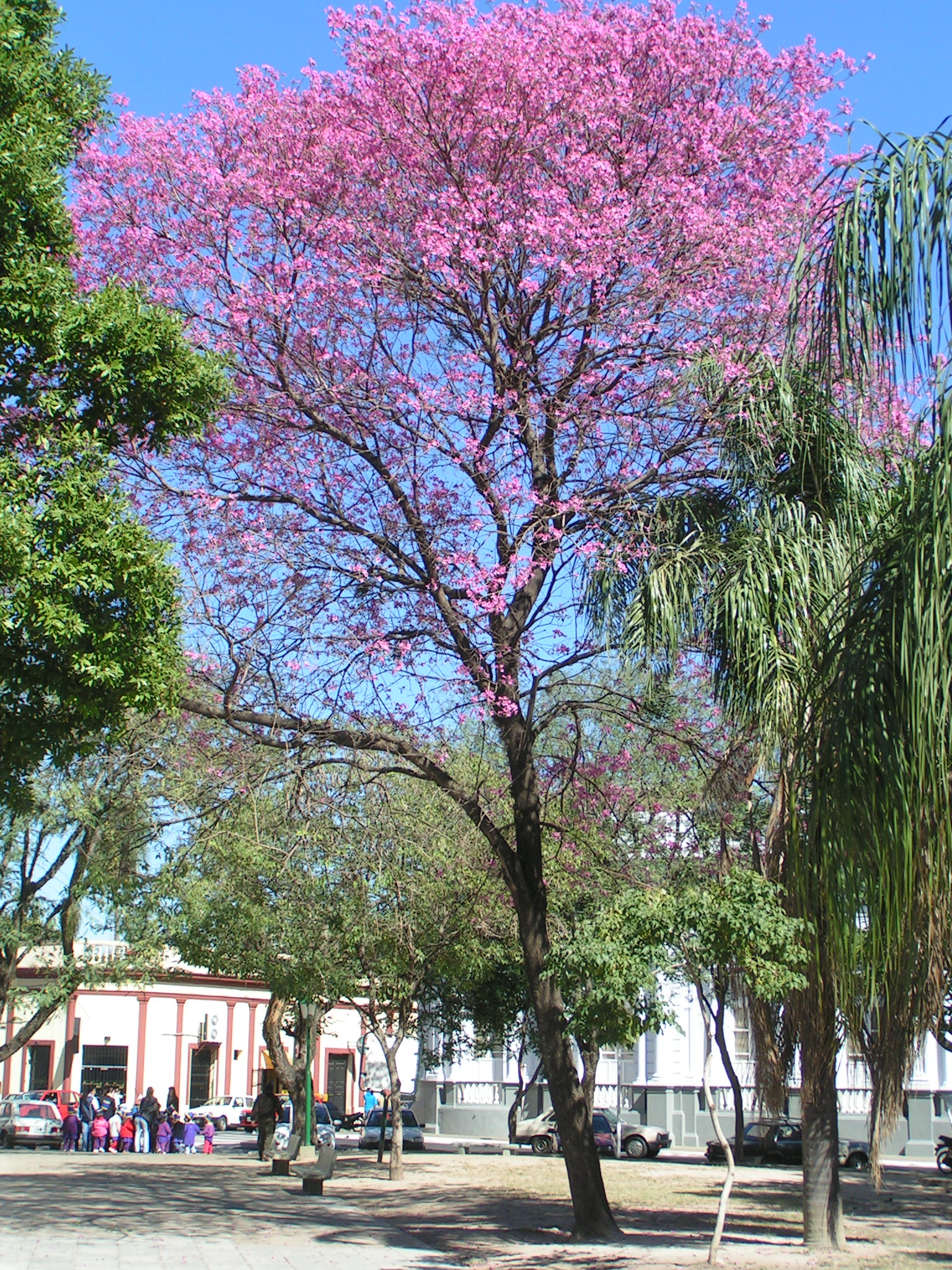- Tabebuia impetiginosa
Taxobox
name = "Tabebuia impetiginosa"

image_width = 200px
image_caption = "Tabebuia impetiginosa" flowering in Corrientes,Argentina .
status = NE
status_system = iucn3.1
regnum =Plant ae
divisio =Magnoliophyta
classis =Magnoliopsida
subclassis =Asteridae
unranked_ordo =Euasterids I
ordo =Lamiales
familia =Bignoniaceae
tribus =Tecomeae
genus = "Tabebuia "
species = "T. impetiginosa"
binomial = "Tabebuia impetiginosa"
binomial_authority = (Mart. ex DC.) Standl.
synonyms ="Handroanthus avellanedae" (Lor. ex Griseb.) Mattos
"Tabebuia avellanedae"Lorentz ex Griseb.
"Tabebuia ipe" (Mart.) Standl.
"Tabebuia palmeri" Rose
"Tecoma avellanedae" (Lor. ex Griseb.) Spreng.
"Tecoma impetiginosa" Mart. ex DC.
"Tecoma ipe" Mart. ex K. Schum."Tabebuia impetiginosa" [ [http://www.ars-grin.gov/cgi-bin/npgs/html/taxon.pl?36147 "Tabebuia impetiginosa"] at
Germplasm Resources Information Network ] , Pink Ipê or Pink Lapacho is a nativeBignoniaceae tree of America, distributed from northern Mexico south to northern Argentina. It is a common tree in Argentina's northeastern region, as well as in southeasternBolivia . It is said to be indigenous to Trinidad and Tobago.It is a conspicuous and well-known species with a long history of human use. Consequently it has a range of local names "ipê-cavatã, ipê-comum, ipê-reto, ipê-rosa, ipê-roxo-damata, lapacho negro, pau d'arco-roxo, peúva" or "piúva". The
timber is sometimes traded as "brazilwood ", which properly refers to the unrelated Pernambuco Tree ("Caesalpinia echinata").Description
[

Inflorescence s] The Pink Lapacho is a rather largedeciduous tree, with trunks sometimes reaching 8 dm width and 30 m height. Usually a third of that height is trunk, and two thirds are its longer branches. It has a large, globous, but often sparse canopy. Leaves are opposite and petiolate, 2 to 3 inches long, elliptic andlanceolate , with lightly serrated margins and pinnatevenation .Its bark is brownish grey, tough and hard to peel. The wood is of a pleasant yellowish colour, barely knotted and very tough and heavy (0,935 kg/dm³). It's rich in
tannin s and therefore very resistant to weather and sunLópez "et al." (1987)] . Unfortunately, it is not very useful for furniture since it is so hard to work by hand. It can be found as beams or fulfilling other structural uses where needed outdoors.Pink Lapacho flowers between July and September, before the new leaves appear. The flower is large, tubular shaped, its corolla is often pink or magenta, though exceptionally seen white, about 2 inches long. There are 4
stamens and astaminode . The fruit consists of a narrow dehiscent capsule containing several winged seeds.The flowers are easily accessible to
pollinator s. Somehummingbird s - e.g.Black Jacobin ("Florisuga fusca") andBlack-throated Mango ("Anthracothorax nigricollis") - seem to prefer them over the flowers of other "Tabebuia " species, while for others like theStripe-breasted Starthroat ("Heliomaster squamosus") it may even be a mainstay food source. [Baza Mendonça & dos Anjos (2005)]Uses
"Tabebuia impetiginosa", as well as other species of this genus, are trees naturally found in the wild of central to South American forests. It is also used as a
honey plant , and widely planted asornamental tree in landscaping gardens, public squares and boulevards due to its impressive and colorful appearance as it flowerslopezetal1987] . Well-known and popular, it is the national tree of Paraguay.The inner
bark of "Tabebuia impetiginosa" is used medicinally [ [http://www.esalq.usp.br/trilhas/medicina/am21.htm?PHPSESSID=82bf340b6b369121eea5b3aeefd6eef5 "Tabebuia avellanedae"] atUniversity of São Paulo ] . It is dried, shredded, and then boiled, making a bitter brownish-colored tea known asLapacho or Taheebo. The unpleasant taste of the extract is lessened when taken in pill form, or as tinctures. Lapacho bark is typically used during flu and cold season and for easingsmoker's cough . It apparently works by promoting the lungs to expectorate and free deeply embedded mucus and contaminates during the first three to ten days of treatment.In
ethnomedicine Lapacho plays an important role for several South American indigenous peoples. In the past decades it has been used byherbalist s as a generaltonic andadaptogen . About the 1980s, its was touted as having "almost unbelievable properties" and said to improve quality of life forcancer and immunodepressed patients [E.g. [http://www.oralchelation.com/taheebo/lapacho1.htm Purple Lapacho: Ancient Herb, Modern Miracle] ] However, the main active compoundlapachol has since turned out to be toxic enough to kill a human imbibing the quantities required for a therapeutic effect on those diseases [E.g. de Cássia da Silveira e Sá & de Oliveira Guerra (2007)] . Still, lapachol has strongantibiotic anddisinfectant properties, and may be better suited fortopical applications. Note that entomedical use of Lapacho and other "Tabebuia" teas is usually short-term, to get rid of acute ailments, and not as a general tonic. Usefulness as a short-term antimicrobial and disinfecting expectorant, e.g. against PCP inAIDS patients, is yet to be scientifically studied.ee also
*
Lapacho
*List of plants of Cerrado vegetation of Brazil Footnotes
References
* (1965): "Flora analitica do Parana".
* (2005): Beija-flores (Aves, Trochilidae) e seus recursos florais em uma área urbana do Sul do Brasil [Hummingbirds (Aves, Trochilidae) and their flowers in an urban area of southern Brazil] . [Portuguese with English abstract] "Revista Brasileira de Zoologia" 22(1): 51–59. doi|10.1590/S0101-81752005000100007 [http://www.scielo.br/pdf/rbzool/v22n1/a07v22n1.pdf PDF fulltext]
* (2007): Reproductive toxicity of lapachol in adult male Wistar rats submitted to short-term treatment. "Phytother. Res." 21(7): 658-662. doi|10.1002/ptr.2141 (HTML abstract)
* (1987): "Árboles comunes del Paraguay: Ñande yvyra mata kuera." Cuerpo de Paz, Asunción.Gallery
}
Wikimedia Foundation. 2010.
